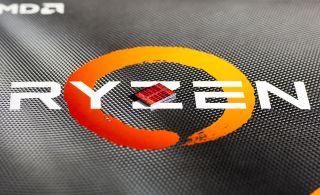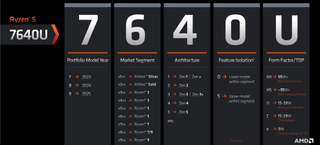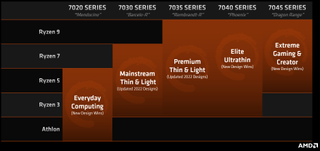AMD Shakes Up Ryzen Mobile Model Naming Scheme Ahead of Mendocino, Dragon Range
"Each digit means something," AMD says.

AMD is changing up the model numbers for its mobile processors, with a new naming system designed to better explain the chip's release year, architecture, TDP and more.
It will begin in 2023 and move forward. AMD's new naming system consists of four digits and at least one letter, which isn't a change from the existing system. But Robert Hallock, director of technical marketing at AMD, wrote in a blog post that "[o]ur current naming system for Ryzen Mobile Processors was at an end. It simply could not accommodate the influx of new SOCs in new categories we're developing."
The short answer here is that bigger numbers means more powerful processors. But each digit has a meaning, should you want to dig in.

In this system, the first digit stands for the year the chip was released. Next gen's 7000-series processors will be the 2023 system, followed by 8000-series in 2024 and so on. The second number details which product line it falls in, ranging from Athlo Silver (1) to Ryzen 9 (9). There is some doubling up in there. An x8xx processor, for instance, could be a Ryzen 7 or a 9, while x7xx is also a Ryzen 7, and x9xx is a Ryzen 9.
The third numeral is the architecture. The number "5," for instance, will use Zen 5, "4" is Zen 4, and so on. The last number is either a 0 or 5 — a lesser or greater model. This will be important in cases where the architecture number doesn't specify different versions of an architecture, like Zen 3 vs. Zen 3+. The letter (or letters) refer to the TDP, ranging from the fanless "e" series at 9W up to HX at 55W or more. We've included AMD's full graphic above.
That third digit, to many, may be most important. You can have two 7000-series chips, but one could use Zen 1 and the other could use Zen 4. That's a key number to look for when buying a laptop.
In this case, a hypothetical Ryzen 9 7955HX would be the most powerful 2023 mobile processor, with Zen 5 and a 55W or higher TDP, while you could still have a slightly lower power Ryzen 9 7955HS. It's easy to see how this could build forward.

This also makes it, to some degree, ways to tell which of the new series of CPUs a processor will fall in. AMD is making these changes ahead of its "Mendocino" launch, which it says is for "everyday computing." That will use the Zen 2 process, which you can tell from the name. This tops out at 7045 with "Dragon Range."
Hallock wrote that this new naming scheme has been "smoke-tested… against a 5-year time horizon." Desktop processors, however, will have no changes, and will continue as they have since Ryzen was launched with the 1000 series.
Stay On the Cutting Edge: Get the Tom's Hardware Newsletter
Get Tom's Hardware's best news and in-depth reviews, straight to your inbox.
Andrew E. Freedman is a senior editor at Tom's Hardware focusing on laptops, desktops and gaming. He also keeps up with the latest news. A lover of all things gaming and tech, his previous work has shown up in Tom's Guide, Laptop Mag, Kotaku, PCMag and Complex, among others. Follow him on Threads @FreedmanAE and Mastodon @FreedmanAE.mastodon.social.
-
shady28 This is a highly deceptive practice.Reply
How many people will buy 7000 series AMD thinking it is a Zen 4, when it is really a Zen 2 from 3 years ago?
They did the same thing with the 5000 series, 5700U is a Zen 2 4700U with like +100Mhz, while 5800U is a Zen 3. -
peachpuff Reply
Yup, the first number being the model year, means they can regurgitate last year's chip as long as they make some minor change to it and release it this year with a higher number. Hopefully this is just for mobile.shady28 said:This is a highly deceptive practice.
How many people will buy 7000 series AMD thinking it is a Zen 4, when it is really a Zen 2 from 3 years ago?
They did the same thing with the 5000 series, 5700U is a Zen 2 4700U with like +100Mhz, while 5800U is a Zen 3. -
shady28 Replypeachpuff said:Yup, the first number being the model year, means they can regurgitate last year's chip as long as they make some minor change to it and release it this year. Hopefully this is just for mobile.
They can get away with this kind of stuff in the US.
The EU doesn't seem so gullible in this regard. I hope they make AMDs OEMs slap stickers on them saying "This CPU is old crap from 2019". -
-Fran- Wait... So they'll still be using the Ryzen # with the new 4 digits already including it? Why are they being redundant there? So dumb, lol.Reply
This is a step in the right direction to explain more plainly all the weird combinations between generations of products instead of forcing people to "google" the CPU name and find out that way. They just need to make this explanation available to everyone right next to the Laptop displays.
Regards. -
King_V There is no conspiracy.Reply
Am I thrilled with it? No. For the new numbering system, they probably should've added a prefix, say, a letter maybe, along with the 4 digits, and the letter(s) suffix.
That way, the new numbering system is obvious. Staring it at 7 is an indicator as well, since nothing else had a number starting at 7000 yet, but it does very much seem like a change in generation.
At least, for those people familiar with and used to it. For new customers, I don't know if this is the confusion point of real confusion. Having been out of the game for a while, I was very confused back in 2012 trying to figure out Intel's model numbers when I ultimately got a Sandy Bridge based system. But first gen was still around, and I didn't know what any of the numbers meant back then. -
TCA_ChinChin Its seems like like one step forward and a half step back with this one. Obviously if this info is widely distributed and AMD educates their audience, it will be nice, but the mixing of generations with the thousands digit is pretty bad no matter how you slice it.Reply -
Kamen Rider Blade :: From the AnandTech article ::“Model year” is the operative term here, as the Mendocino APUs would be the first products to use the new numbering system, even though they’re launching in the tail end of 2022. So similar to automobiles, AMD is operationally giving themselves some leeway to fold end-of-year products into the following calendar year.Reply
In accordance with AMD’s APU mixing, this also gives AMD further room to recycle/refresh existing parts for future model years by incrementing the model year number. To be sure, AMD is already doing this with parts like the Renoir/Zen 2-based Ryzen Mobile 5000 chips, which in turn has led to some of the confusion AMD is looking to resolve with their new numbering system. One way or another, OEMs want to have parts with “current” model year numbers, and as AMD isn’t going to be doing top-to-bottom overhauls of its mobile APU architecture every single calendar year, this is the compromise to allow AMD to refresh their hardware as development and market conditions allow.
:: From the AnandTech forums ::Furthermore, the 4000 and 6000 happened precisely because AMD wanted to avoid the backlash that having mobile and desktop being out-of-sync in terms of technology despite releasing around the same time had created up until that point.
Ryzen mobile (zen1, first gen, Raven Ridge) launched around the same time or only slightly before the Ryzen 2000 (zen1+, second gen, Pinnacle Ridge) chipsets. If they launched it at 1000 series, they would be releasing products that customers would associate with being old (as in the desktop 1000 series). Customers, for example, looking at AMD Ryzen 2000 desktop might think, I want a laptop with "AMD Ryzen" but I want the latest, so surely I would be looking for a Ryzen 2000 mobile.
TLDR; the out-of-sync timing of AMD's mobile/desktop chipset release cadences is why the naming was a bit messed up.
This allowed AMD to appease the biggest customers in the consumer space - the big OEMs that sell vastly more CPUs than what is used in DIY markets - all the while also not misleading the DIYers.
But now people are complaining that the numbering isn't simple. It's like the classical pick 2 out of 3 situation, options being:simple numbering,informative numbering andOEM-sellable numbering.:: My thoughts ::Most of this was taken from the AnandTech article & Forum Postings on AnandTech about this subject.
In the end, I think Marketing went with Options 2 & 3
Is this optimal, nope.
But this is what the marketing people at AMD choose to solve their Mobile Numbering issue that was a problem that started from way back in the day.
They also want to be able to sell older mobile APU's while being honest about it.
They also wanted OEM's to have the latest iteration of whatever APU's they be selling.
This was a "Hard Compromise" to meet all those requirements.
It sucks, nobody is particularly happy, but it needed to be done to meet all those complicated requirements.
It's a compromise and as with any good compromise; all sides will have things they don't like, but will have to accept to get what they want. -
david germain Reply
is there a print error on the second image. x5xx = Ryzen 5 x6xx = Ryzen 5Admin said:AMD has upd its mobile CPU model numbers for 2023 ahead of a new range of CPUs, including Mendocino and Dragon Range.
AMD Shakes Up Ryzen Mobile Model Naming Scheme Ahead of Mendocino, Dragon Range : Read more
no Ryzen 6 or is the second R5 actually the R5x?
yeah that Market Segment area is a mess. thats going to need a triple read before hitting buy. -
Kamen Rider Blade Reply
Honestly, the 4, 6, 8 should be reserved for DeskTop APU variants for the sake of consistency with mobile naming since it's a mobile first part.david germain said:is there a print error on the second image. x5xx = Ryzen 5 x6xx = Ryzen 5
no Ryzen 6 or is the second R5 actually the R5x?
yeah that Market Segment area is a mess. thats going to need a triple read before hitting buy.
Most Popular



